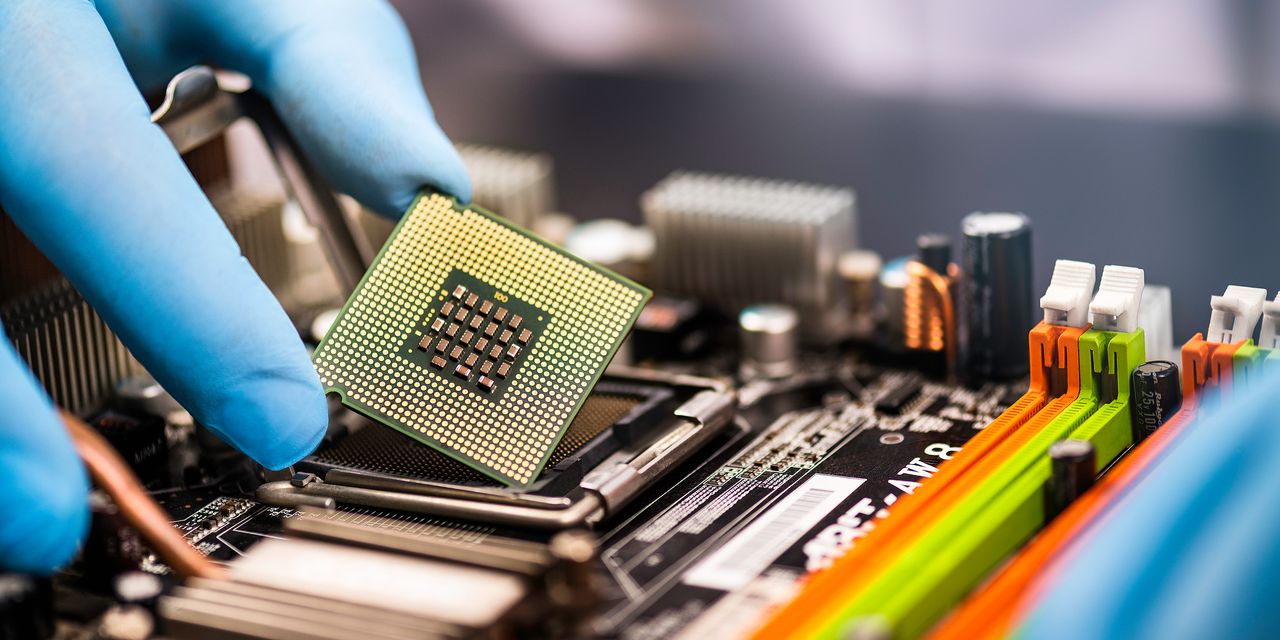A seismic shift is happening in the semiconductor industry right now. This transformation is not merely a technological evolution; it’s a financial game-changer that will significantly impact the portfolios of many investors.
The most advanced microprocessor in the consumer market today wasn’t designed by a traditional chip company but by Apple
AAPL,
The company has not only set a new standard for processing power, but it also saved approximately $2.5 billion per year by switching from Intel
INTC,
chips to its in-house silicon in 2021. Not only is Apple’s chip more cost-effective, it is also more power efficient and is designed specifically for use with macOS, making the integration between Apple’s software and hardware seamless.
The story of Apple silicon is a clear demonstration of the financial and technological benefits that come with in-house chip design. This is a trend that’s rapidly gaining traction across the tech industry. This year alone, Alphabet
GOOGL,
Meta Platforms
META,
Amazon.com
AMZN,
and Microsoft
MSFT,
have announced plans to develop in-house silicon, specifically for AI applications. Meanwhile, Tesla
TSLA,
designed its own full-self-driving (FSD) processor for its cars as well as its own AI chip for the Dojo supercomputer. Tesla’s AI chip, known as the D1, costs about 1/6th the price of NVIDIA’s
NVDA,
H100. This is a harbinger of the reckoning on the horizon for much of the semiconductor industry.
Fabless companies are less needed
Fabless semiconductor companies such as Broadcom
AVGO,
Qualcomm
QCOM,
and Advanced Micro Devices
AMD,
have four key attributes that combine to form their value proposition: intellectual property; software/integration; talent/know-how, and distribution. Yet as big tech companies grow in both scale and technological capability, the relative value of fabless companies diminishes in value.
Apple, Alphabet, Tesla and others can simply design the chips they most need and outsource the manufacturing to Taiwan Semiconductor (TSMC)
TSM,
Samsung Electronics
005930,
or Intel, all while saving billions of dollars in costs. The tech giants are increasingly capable of designing chips that are specifically tailored to integrate seamlessly with their proprietary software and hardware ecosystems.
This is a crucial point for investors: the fabless companies that have been stalwarts in many tech portfolios may face significant revenue losses if they don’t adapt to this evolving landscape.
Build or buy?
Despite the huge incentive the tech giants have to switch to in-house silicon, it is not always a straightforward decision. Companies must consider scale, as the volume of chips needed must justify the cost and effort of in-house design. Capability is another crucial factor. Only the largest companies like Apple and Tesla have the talent, intellectual property, and capital to design their own chips.
The need for specificity is also vital; the chip must be tailored to the specific application, whether it’s a smartphone, a data center, or a self-driving car. If generic chips are good enough to do the job, there is simply no need to design an application-specific semiconductor. Efficiency and power consumption are increasingly important, especially for companies like Apple, where battery life is a key selling point. Intel’s cutting-edge chips can fully compete with Apple’s on a performance basis, but Apple’s ARM-based chips steal the show with their power efficiency. Finally, cost is a major driver. The potential savings can be enormous, as demonstrated by both Apple and Tesla. But given the complexities of designing chips in-house, we expect the shift to in-house silicon will gradually grow over the course of the next decade.
The foundry factor
Dedicated foundries such as TSMC are able to produce chips designed by Apple, Alphabet and Tesla, just like they have for years for fabless companies such as Broadcom and Qualcomm. Semiconductor content will continue to grow across all end markets, but it should only be accelerated by AI’s extremely high need for computing power.
Currently, only TSMC, Intel, and Samsung have the capabilities to manufacture the world’s most advanced chips. These companies are also making significant investments in additional foundries in the U.S. and Europe, and they are attempting to diversify geographically away from dependence on Taiwan.
Intel is investing roughly $120 billion in investments in new and upgraded fabs. We see Intel as one of the prime beneficiaries of the Great Semiconductor Shift, as it will be well-positioned to produce advanced chips for big tech companies in the U.S. and Europe. We won’t be surprised if Intel’s Foundry Services (IFS) division gets spun off from the rest of the company once it reaches a multi-billion dollar run rate, which we expect within the next two to three years.
Implications for investors
For investors, the implications of this shift are both clear and substantial. The semiconductor industry is at a pivotal juncture, and companies that fail to adapt could see their stock prices plummet, affecting a wide range of portfolios. Conversely, foundries and companies that successfully transition to meet the demands of in-house silicon will be great investment opportunities. Given the scale of this transformation — a multi-trillion-dollar shift — it’s crucial for investors to assess their holdings across the semiconductor industry.
This is not merely a technological shift; it’s a financial paradigm change that investors can’t afford to ignore. After conducting a comprehensive view of the industry, our three favorite stocks are Intel, TSMC, and STMicroelectronics
STM,
Our least favorite companies right now are Seagate Technology Holdings
STX,
Broadcom, and SiTime Corp.
SITM,
Cody Willard is founder of 10,000 Days Fund Capital Management and runs the 10,000 Days Fund, a hedge fund. Bryce Smith is an analyst at 10,000 Days Fund Capital Management. At the time of publication, Willard and/or his hedge fund were long AAPL, GOOG, TSLA, NVDA, INTC, TSM, STM and were net short STX, AVGO, SITM, SOXX, SMH. Positions can change without notice.
More: Semiconductor companies are in denial about potentially losing their biggest customers
Also read: Apple’s new Mac laptops aren’t good enough to keep buyers from switching to PCs
Read the full article here







